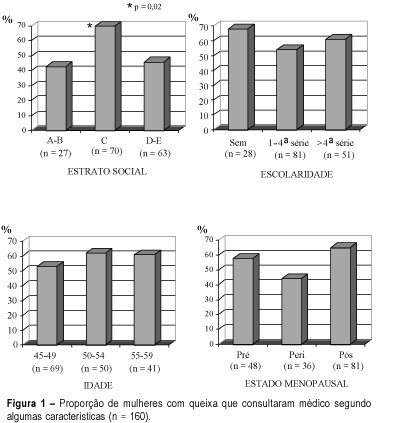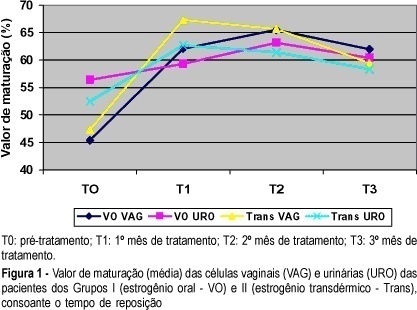Summary
Revista Brasileira de Ginecologia e Obstetrícia. 2001;23(10):641-646
DOI 10.1590/S0100-72032001001000005
Purpose: to evaluate the prevalence of bacterial vaginosis (BV) in menopausal and in infertile outpatients and to analyze the current clinical diagnostic methods. Methods: we evaluated retrospectively 104 menopausal women and 86 with infertility. Characteristic vaginal discharge on gynecological examination, pH >4.5, positive KOH whiff test, and bacterial vaginosis by Gram test were considered positive. BV was established when at least 3 out of 4 criteria were found. Results: among the menopausal women, 29 patients (28.1%) were clinically positive for BV, 10 (9.6%) had positive whiff test, 68 (65.4%) vaginal pH >4.5, and 34 (32.7%) positive Gram test. For the infertile patients the figures were 20 (23.2%), 13 (15.1%), 61 (70.9%) and 26 (30.2%), respectively. According to our established criteria, BV was diagnosed in 14 menopausal (13.5%) and 15 infertile (17.4%) women. Conclusion: bacterial vaginosis prevalence was similar in both groups of patients. In addition, all diagnostic criteria should be followed in order to avoid underdiagnosing this pathology or treating an otherwise normal vaginal flora.

Summary
Revista Brasileira de Ginecologia e Obstetrícia. 2001;23(7):439-443
DOI 10.1590/S0100-72032001000700005
Purpose: to evaluate the percentage of 45- to 60-year-old women complaining of urinary incontinence, who look for medical treatment, and the factors possibly associated with the decision of visiting the doctor and the reasons for not doing so. Methods: a secondary analysis of a population-based survey on climacterium and menopause in women living in the city of Campinas, São Paulo state, was carried out through a descriptive, exploratory and cross-sectional population study. A total of 456 women between 45 and 60 years of age were selected through a sampling process. The age at menopause and its associated factors were evaluated, as well as the prevalence of climacteric symptoms, the use of medical care, self-perception of the health status, and the sociocultural, sociodemographic and socioeconomic characteristics. Urinary incontinence complaint and the search for medical help due to the presence of symptoms were explored. The data were collected through home interviews, using a structured and pretested questionnaire provided by the International Health Foundation/International Menopause Society and by the North American Menopause Society, and adapted by the authors. The statistical analysis was performed using Fisher's exact test. Results: thirty-five percent of the interviewees reported constant or intermittent stress incontinence, although only 59% of the patients with the complaint sought medical help. Conclusion: the majority of the women presenting urinary incontinence do not complain to the doctor if they are not questioned objectively.

Summary
Revista Brasileira de Ginecologia e Obstetrícia. 2002;24(9):573-577
DOI 10.1590/S0100-72032002000900002
Objective: to study the effects of oral or transdermal estrogen replacement on the lower urinary tract and vagina in postmenopausal women. Methods: we studied 25 postmenopausal women evaluating the oral or transdermic estrogen replacement effects on the vaginal cells and urinary sediment during 3 months. The patients were randomly distributed into 2 groups: Group I, n = 14, treated orally with 0.625 mg equine conjugated estrogen plus 5 mg medroxyprogesterone acetate, daily for 3 months; Group II, n = 11, treated transdermally with 50 mug 17-ß-estradiol, once a week, plus 5 mg medroxyprogesterone. Daily, for 3 months, urinary samples were collected from the first miction in the morning after urogenital antisepsis into sterile tubes. The sample was centrifuged and the sediment was smeared. Vaginal and urinary smears were then fixed in absoluted alcohol and stained by the method of Shorr. Results: the patients who used the oral route presented maturation of the vaginal cells (from 45.4 to 65.5% after 2 months of treatment, maintaing 62% afterwards) but this did not occur with urinary cells (56.4 before treatment versus 60.4% at the end of the period). The transdermal route promoted maturation of vaginal and urinary cells. Conclusion: we have concluded that transdermal estrogens have satisfactory effects both on vaginal and urethral sites. However, with the oral route we did not find the expected results in the urinary tract in all cases.

Summary
Revista Brasileira de Ginecologia e Obstetrícia. 2002;24(8):541-545
DOI 10.1590/S0100-72032002000800007
Purpose: to evaluate the diagnostic accuracy of sonohysterography as a diagnostic method for the evaluation of the uterine cavity in postmenopausal women with abnormal uterine cavity at conventional endovaginal sonography. Methods: this study consisted of the evaluation of 99 postmenopausal patients with abnormal uterine cavity on conventional endovaginal sonography, that was defined as endometrial thickness equal to or larger than 5 mm in a postmenopausal patient not on hormone replacement therapy, or endometrial thickness equal to or larger than 8 mm in patients on hormone replacement therapy, with irregular bleeding. These patients were subjected to sonohysterography, and specimens were obtained for pathologic examination by biopsy guided by histeroscopy in 92 patients, endometrial biopsy in four patientes and hysterectomy in three patients. The results of sonohysterography were compared with the pathologic findings, considered "gold standard". Results: there were eight cases of normal uterine cavity and 20 cases of atrophic endometrium and sonohysterography had high levels of specificity (97.8 and 97.5%) and low sensitivity (35 and 25%). There were high levels of sensitivity (92.3 and 75.0%) and specificity (94.1 and 97.9%) for polyps (65 cases) and submucous myomas (four cases). There were three cases of endometrial carcinoma and the sonohysterography had a sensitivity and specificity of 100%. Conclusions: sonohysterography showed to be accurate in the diagnostic of focal diseases (endometrial polyps and submucous myomas). There were three cases of endometrial cancer, and sonohysterography correctly diagnosed all of them. This method was also accurate to exclude endometrial abnormality. However, in the cases of diffusely thickened endometrium, the accuracy was low, because atrophic and normal endometrium on histopathology frequently appears as diffusely thickened endometrium at endovaginal sonography and sonohysterography. Sonohysterography did not lead to complications during and after the procedure.
Summary
Revista Brasileira de Ginecologia e Obstetrícia. 2002;24(8):547-552
DOI 10.1590/S0100-72032002000800008
Purpose: to evaluate the estrogenic effects of soy phytoestrogens in postmenopausal patients. Method: we selected postmenopausal patients from the Climacteric Service of the Gynecology Department of the Federal University of São Paulo - Escola Paulista de Medicina. The patients were divided into two groups: GI (n=40) received daily 100 mg isoflavone (3 x 33.3 mg/day); and GCtr (n=40) received daily placebo. We included in this study the Kuppermann menopausal index, physical examination and the biochemical determination of total and fractions of cholesterol, triglycerides, estradiol, FSH e LH. We also performed sonographic examination to measure endometrial thickness. To compare baseline and after treatment values of both groups, the nonparametric Kruskal-Wallis test was used for the Kuppermann index, while the t test was performed for other data. Results: evaluation of the Kupperman Menopausal Index, 80% patients of GI showed a decrease in the total score, while the improvement of symptoms in GCtr was 12,5%. The analysis of total cholesterol levels showed that 35 patients of GI had levels above 200 mg/dL, and only 13 of GCtr presented similar levels. The body mass index reduction occurred in GI and the control group showed no changes. We also verified that echo endometrial thickness and FSH levels were similar to baseline values. However the values of estrogen increased after isoflavone treatment. Conclusion: we concluded that 100 mg/day isoflavone may be an alternative treatment for attenuating the climacteric symptoms in 80% of isoflavone users and that it reduced total cholesterol.
Summary
Revista Brasileira de Ginecologia e Obstetrícia. 2002;24(7):441-446
DOI 10.1590/S0100-72032002000700003
Purpose: to evaluate the reproductive aspects in climacteric women of the Family Health Program in Cuiabá. Methods: it was a cross-sectional study including 354 women, with ages between 40 and 65 years, attended at the Central-Western District Family Health Program of Cuiabá. A pretested questionnaire with specific questions regarding the present study was used. Data were analyzed using the Z test and chi² test for trend. The mean age of the 354 women was 49.7±7 years and the median 48 years. A total of 243 (68.6%) were born in Mato Grosso, and the others were migrants from different states. Most were married (65.8%), white (48.0%), catholic (73.4%), and had low schooling: 62.4% did not finish the elementary school and 19.2% were illiterate. About 84% were occupied only in domestic activities, and more than a half (58.2%) belonged to a lower social class. Results: the average number of pregnancies was 5.4±3.3. Nearly 5% were nulliparous and 7% had more than ten children. Almost 50% had the first pregnancy in adolescence and 14% after the age of 40 years. A total of 229 women (65%) were submitted to pelvic surgery: 78% to tubal sterilization, 20% to hysterectomy, and 7% to bilateral oophorectomy. Menopause was due to hysterectomy/oophorectomy in 25% of the women. Conclusion: almost 65% of the women were submitted to a pelvic surgery. The most frequent surgery was tubal sterilization followed by total hysterectomy.